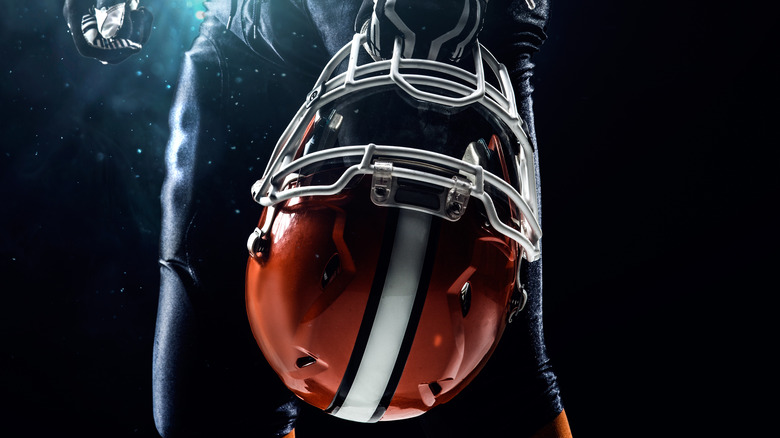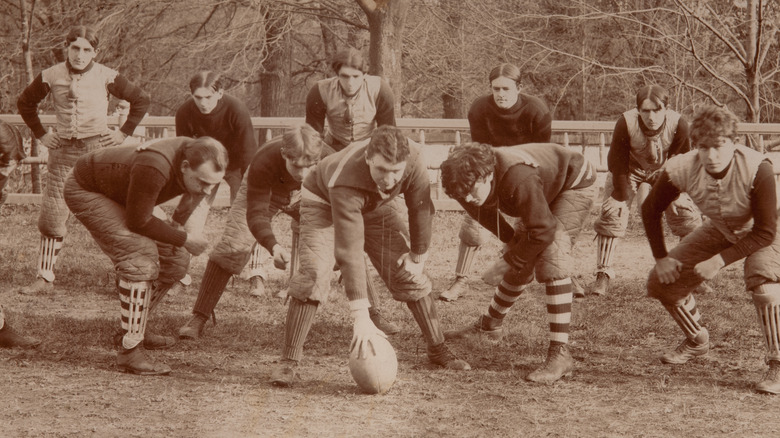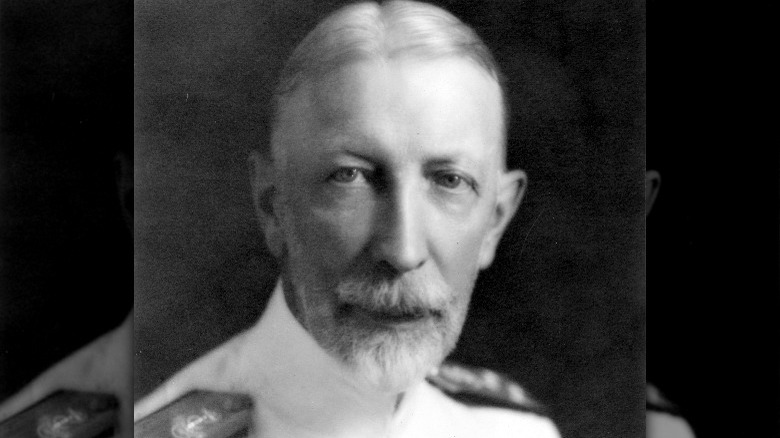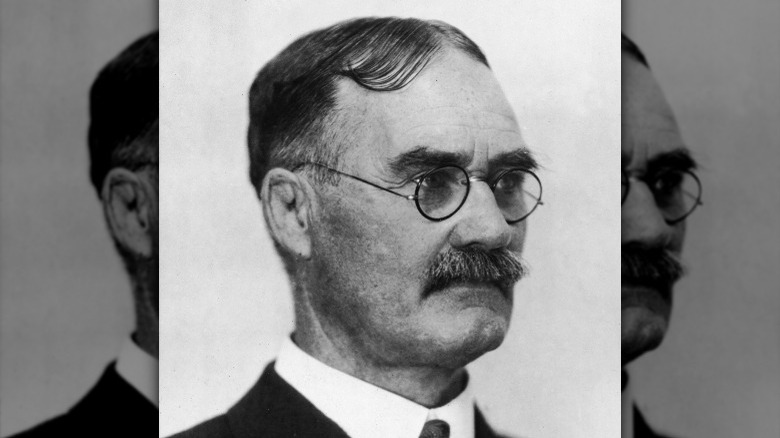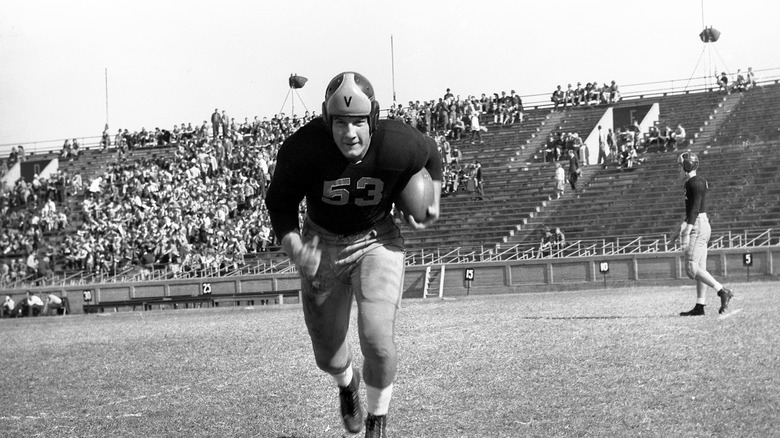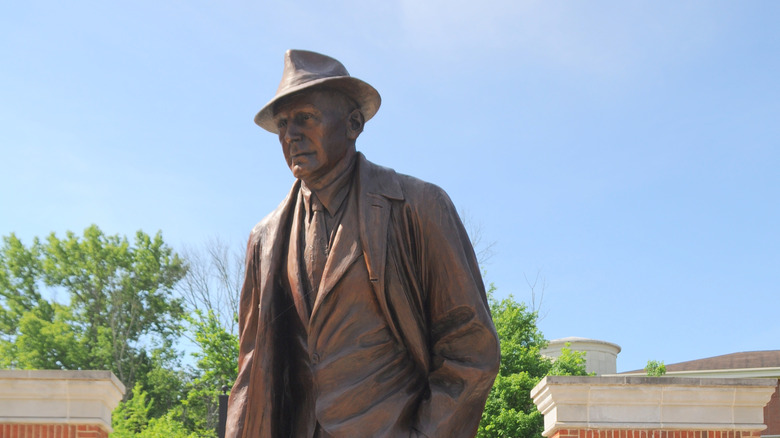Who Invented The First Football Helmet?
The football helmet, maybe more so than any other piece of equipment, is synonymous with its sport. Don't believe that? Go look at the Cleveland Browns' logo. It's a football helmet. A football team whose logo is a football helmet. The same helmet that they wear every weekend. Now that's branding synergy.
The football helmet serves the obvious utilitarian purpose of protecting the wearer's noggin when they're inevitably waffled by a linebacker. It's the most focused-on piece of equipment in the game because of its importance. Large sums of money are spent to develop newer, stronger, and lighter helmets.
According to Smithsonian, despite all of the attention it gets, the origin of the football helmet isn't particularly clear. Some have offered the explanation that the man behind the first football brain bucket was none other than James Naismith, the man whose other major contribution to the sports world was the game of basketball, which he invented (via Los Angeles Times).
A brief history of early American football
Football is the name of several different sports. In the vast majority of the world, football means you're talking about the sport known to Americans as soccer. Other footballs are associated with the country where they were developed or became popularized, i.e. American football, Canadian football, and Australian rules football. Canadian football is essentially the same as American football with a few rule changes to keep people on their toes, like three downs, 12 players on the field per side, and goal posts placed in a seemingly dangerous spot directly on the goal line.
North American football (sometimes called gridiron football, per History) and Australian rules football share a common relative: rugby. Rugby was being played in the northeastern United States in the 1800s, and a group at Harvard played something called the Boston game during the 1870s. The Boston game was an early cross between rugby and soccer. Harvard played against Canada's McGill University using McGill's set of rules, which skewed more toward rugby. Harvard's players decided they preferred this game and adopted it for themselves. Harvard and their big rivals, Yale University, played a game under these rules in 1875, but it was Yale's Walter Camp who is credited with morphing the original game into what is currently known — at least in North America — as football.
Helmets were thought of well before they were widely in use
It didn't take very long before some football players were sick of getting hit in the head, because some explanations for who invented the first football helmet place it as far back as the 1890s. One person credited with being the first to debut some archaic form of football helmet was Admiral Joseph Mason Reeves (via Smithsonian). Reeves served during World War I but is best known in military history circles for what he did after the war. He was named commander of the first aircraft carrier, USS Langley, and was instrumental in coming up with tactics and procedures for a type of ship that was brand new at the time.
Several decades earlier, while still attending the U.S. Naval Academy, Reeves was a good football player and took part in one of the most historic rivalries in college sports: the Army-Navy football game. The story goes that ahead of the big game, Reeves — who had taken his fair share of shots to the cranium — was told that any more could result in permanent damage, or as the doctor allegedly put it, instant insanity. (Of course, with the benefit of hindsight, we know that any of the previous hard hits could've left the future naval commander with permanent damage, but that's late-19th century medicine for you.) Determined to play despite his doctor's warning, Reeves is said to have gone to a shoemaker and had them craft the helmet, which despite not seeing much use on the football field in later years, was the basis for helmets worn by early paratroopers.
Could the guy who invented basketball also have invented football helmets?
James Naismith's claim to fame is that he invented the sport of basketball. As a nod to this, the trophy awarded each year to the college basketball's top player is called the Naismith Trophy. Could one guy have had such a huge impact on two completely different sports? According to one story, he could have.
According to the Los Angeles Times, Naismith was born in Canada and studied to be a minister at McGill University, the school whose rules for football were shuttled to the United States by players from Harvard. While there, Naismith served as a physical education instructor, and by 1890 he had decided to pursue physical education instead of theology and moved to Springfield, Massachusetts, where he attended the Young Men's Christian Training School. This is the same place where he would eventually invent basketball.
At the school, he met Amos Alonzo Stagg, who had played football at Yale and is often credited with being one of the sport's biggest pioneers. The school decided to start its own football team, which Naismith was a part of. Naismith played center, which meant that he was frequently taking shots to the head, to the point that he developed cauliflower ear. To combat this, he and his future wife, Maude, crafted a headpiece out of flannel; future incarnations were made of more durable leather that he could wear. It wasn't necessarily a helmet, but it was inarguably a piece of protective headgear.
Neither one of these early helmets caught on
The prototypes designed by Reeves and Naismith never really caught on, but obviously, the need was there because by the early 20th century some players were sporting leather skull caps. The earliest versions of these were made out of soft leather, but about 20 years later players started to wear headgear made from harder leather which would've offered some more protection (via Smithsonian).
Helmets only became mandatory in 1943, which was after the first helmets utilizing a plastic outer shell were introduced by John T. Riddel. Plastic was hard to come by during World War II, but following the war Riddel went about producing his helmets once again. The first batch of them, however, suffered from a significant problem — they were breaking.That led to a ban on plastic helmets, which only lasted one year, until Riddel managed to work out the kinks and produced a non-breaking plastic helmet. Riddel (the company, not the guy) is still one of the major helmet manufacturers to this day and you'll see their branding on helmets worn by players at all levels, from Pop Warner to college to the NFL.
One legendary coach was responsible for two helmet innovations
While he had no hand in inventing helmets, it's still worth noting the impact Paul Brown had on their development. It's also fitting that the team to debut two major innovations in helmet technology was the Cleveland Browns, the same team whose logo is a helmet. Both of these were thought up by the team's namesake coach (via Britannica).
The first innovation was birthed out of necessity. According to Smithsonian, Brown and company were in the middle of a game when their star quarterback, Otto Graham, took a shot to the mouth that seemed likely to put him out of the game. The legendary coach called for a member of the equipment staff to put a piece across the front of Graham's helmet to protect his face. It was effectively the first football facemask, and it allowed Graham to finish the game. The Browns fully adopted facemasks and they became mandatory across the league in the early '60s.
The second innovation was done out of the desire for a competitive edge. Brown put a radio in his quarterback's helmet way back in 1956. According to Sports Illustrated, when other teams found out what the Browns were doing they were none too pleased, but Brown didn't care and continued using the helmet radio until NFL commissioner Bert Bell outlawed it. That ban was in place until the NFL re-introduced the concept league-wide in the 1990s.
